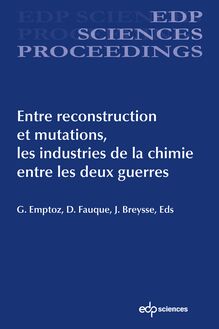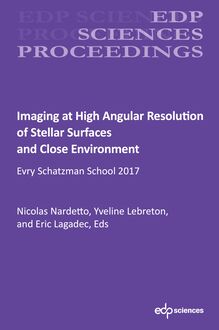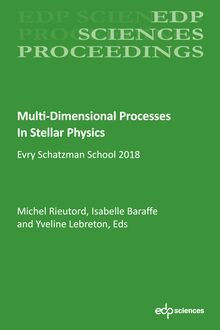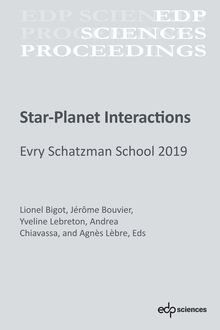Statistics for astrophysics , livre ebook
260
pages
English
Ebooks
2022
Obtenez un accès à la bibliothèque pour le consulter en ligne En savoir plus
Découvre YouScribe et accède à tout notre catalogue !
Découvre YouScribe et accède à tout notre catalogue !
260
pages
English
Ebooks
2022
Obtenez un accès à la bibliothèque pour le consulter en ligne En savoir plus
Publié par
Date de parution
15 février 2022
EAN13
9782759827411
Langue
English
Poids de l'ouvrage
5 Mo
This book is the result of the 2019 session of the School of Statistics for Astrophysics (Stat4Astro) that took place on October, 6 to 11, 2019, at Autrans near Grenoble, in France. The topic of this fourth session was the time series that, from celestial mechanics to gravitational waves, from exoplanets to quasars, concern nearly all the astrophysics. Variable phenomena are ubiquitous in the Universe: periodic (orbits, cycles, pulses, rotations...), transient (explosions, bursts, stellar activity...),random (accretion, ejection...) or regular (apparent motions...). The detection, the characterization and the classification of these variabilities is a discipline of statistics called time series analysis.
Time series analysis is not new in astrophysics, but has been the subject of major developments in many other disciplines (meteorology, finance, economy, medical sciences...). In this book,you will find lectures from two statisticians who are experts in this field.Gérard Grégoire, who has a long experience in econometrics and made a huge contribution to both this book and the session. He covers the basic elements of classical L2 time series, in the time domain as well as in the frequency domain, for univariate and multivariate series, and provides also tools for statistical inference. He gives an extensive presentation of ARMA and ARIMA series, and addresses some related advanced topics. He also devotes a chapter to linear Gaussian state space models and Kalman filtering that will be helpful to follow the last chapter written by Éric Moulines and collaborators: this final chapter is dedicated to state space models in a general framework and sequential MonteCarlo methods to leverage recursions generalizing the Kalman recursions for filtering and smoothing. Many practical exercises are given using the R environment.
Foreword 7
1 - AN OVERVIEW OF THIS BOOK
Examples of time series. Modelization by linear regression
Gérard Grégoire 9
2 - TIME SERIES, FUNDAMENTAL CONCEPTS
Gérard Grégoire 35
3 - ARMA AND ARIMA TIME SERIES
Gérard Grégoire 77
4 - COMPLEMENTS AND APPLICATIONS
Gérard Grégoire 145
5 - KALMAN FILTER AND TIME SERIES
Gérard Grégoire 181
6 - AN INTRODUCTION TO STATE SPACE MODELS
Randal Douc, Éric Moulines & David Stoffer 215
Publié par
Date de parution
15 février 2022
EAN13
9782759827411
Langue
English
Poids de l'ouvrage
5 Mo
Statstcs for Astrophysics
Time Series Analysis
Didier Fraix-Burnet, Gérard Grégoire, EdsStatstcs for Astrophysics
Time Series Analysis
Didier Fraix-Burnet and Gérard Grégoire, Eds
This book is the result of the 2019 session of the School of Statstcs for Astrophysics
(Stat4Astro) that took place on October, 6 to 11, 2019, at Autrans near Grenoble,
in France. The topic of this fourth session was the time series that, from celestial
mechanics to gravitational waves, from exoplanets to quasars, concern nearly
all the astrophysics. Variable phenomena are ubiquitous in the Universe: periodic
(orbits, cycles, pulses, rotations...), transient (explosions, bursts, stellar
activity...), random (accretion, ejection...) or regular (apparent motions...). The
detection, the characterization and the classification of these variabilities is a
discipline of statistics called time series analysis.
Time series analysis is not new in astrophysics, but has been the subject of major
developments in many other disciplines (meteorology, finance, economy, medical
sciences...). In this book, you will find lectures from two statisticians who are
experts in this field. Gérard Grégoire, who has a long experience in econometrics
and made a huge contribution to both this book and the session. He covers the
basic elements of classical L2 time series, in the time domain as well as in the
frequency domain, for univariate and multivariate series, and provides also tools
for statistical inference. He gives an extensive presentation of ARMA and ARIMA
series, and addresses some related advanced topics. He also devotes a chapter
to linear Gaussian state space models and Kalman filtering that will be helpful
to follow the last chapter written by Éric Moulines and collaborators: this final
chapter is dedicated to state space models in a general framework and sequental
Monte Carlo methods to leverage recursions generalizing the Kalman recursions
for filtering and smoothing. Many practical exercises are given using the R
environment.
www.edpsciences.org
Stas cs for Astrophysics
Time Series Analysis
Didier Fraix-Burnet, Gérard Grégoire, Eds
6-11 October 2019, Autrans – FrancePrinted in France
ISBN(print): 978-2-7598-2740-4 – ISBN(ebook): 978-2-7598-2741-1
All rights relative to translation, adaptation and reproduction by any means whatsoever
are reserved, worldwide. In accordance with the terms of paragraphs 2 and 3 of Article 41
of the French Act dated March 11, 1957, “copies or reproductions reserved strictly for
private use and not intended for collective use” and, on the other hand, analyses and short
quotations for example or illustrative purposes, are allowed. Otherwise, “any
representation or reproduction – whether in full or in part – without the consent of the
author or of his successors or assigns, is unlawful” (Article 40, paragraph 1). Any or reproduction, by any means whatsoever, will therefore be deemed an
infringement of copyright punishable under Articles 425 and following of the French Penal
Code.
© EDP Sciences, 2022 Organisers
Didier Fraix-Burnet, Univ. Grenoble Alpes, CNRS, IPAG, France
G´erard Gr´egoire, Univ. Grenoble Alpes, LJK, Grenoble, France
St´ephane Girard, Inria Rhˆone-Alpes, France
Lecturers
G´erard Gr´egoire, Univ. Grenoble Alpes, LJK, Grenoble, France
´ ´EricMoulines,EcolePolytechnique/Acad´emiedesSciences,Paris,France
Marianne Clausel,Universit´e de Lorraine, Nancy, France
Acknowledgments
We thank our sponsors:
Institut de Plan´etologie et d’Astrophysique de Grenoble (IPAG)
Inria Grenoble Rhˆ one-Alpes
Universit´e Grenoble Alpes
Idex Communaut´e Grenoble Alpes
Grenoble INP
Laboratoire Jean Kuntzmann (LJK)
Programme National de Cosmologie et Galaxies (PNCG), Institut
National des Sciences de l’Univers (INSU), CNRS
Programme National Gravitation, R´ef´erences, Astronomie, M´etrologie
(PNGRAM),InstitutNationaldesSciencesdel’Univers(INSU),CNRS
Programme National de Physique Stellaire (PNPS), Institut National
des Sciences de l’Univers (INSU), CNRS
´Programme National Hautes Energies (PNHE), Institut National des
Sciences de l’Univers (INSU), CNRS
PERSYVAL-lab, Grenoble
GdR MaDICS (CNRS)In addition to the participants below, are also present on the photo:
G´erard Gr´egoire, Marianne Clausel, Didier Fraix-Burnet, St´ephane Girard
List of Participants
BHATTA Gopal, Astronomical observatory, Jagiellonian University, Poland
BLAINEAU Tristan, Laboratoire d’Astrophysique de Lyon, France
´GOMEZ-GARRIDO Miguel, Observatorio Astron´omico Nacional, Spain
KRISHNANSaikruba,CentrumAstronomiczneim. MikolajaKopernika,Poland
LACEDELLI Gaia, Dipartimento di Fisica e Astronomia, University of Padova,
Italy
LECLERC Aurelia, Institut de Plan´etologie et d’Astrophysique de Grenoble,
France
MANTHOPOULOU Eleni-Evangelia, Dipartimento di Fisica e Astronomia,
University of Padova, Italy
MARQUETTEJean-Baptiste,Laboratoired’AstrophysiquedeBordeaux,France
MERLE Thibault, Institut d’Astronomie etysique, Universit´eLibrede
Bruxelles, Belgium
MONTOLI Alessandro, Physics Department, Universit`a degli Studi di Milano,
Italy
ORLITOVA Ivana, Astronomical Institute, Czech Academy of Sciences, Czech
Republic
PERES Ricardo, University of Zurich, Switzerland
ROGGERO Noemi, Institut de Plan´etologie et d’Astrophysique de Grenoble,
France
ROQUETTE Julia, Department of Physics & Astronomy, University of Exeter,
UK
SREEJITH Sreevarsha, Laboratoire de Physique de Clermont-Ferrand, FranceTable of Contents
Foreword 7
1 - AN OVERVIEW OF THIS BOOK
Examples of time series. Modelization by linear regression
Gérard Grégoire 9
2 - TIME SERIES, FUNDAMENTAL CONCEPTS Grégoire 35
3 - ARMA AND ARIMA TIME SERIES
Gérard Grégoire 77
4 - COMPLEMENTS AND APPLICATIONS Grégoire 145
5 - KALMAN FILTER AND TIME SERIES
Gérard Grégoire 181
6 - AN INTRODUCTION TO STATE SPACE MODELS
Randal Douc, Éric Moulines & David Stoffer 215 Foreword
The topic of the 2019 session was the time series (including variabilities
and transient events) that, from celestial mechanics to gravitational waves,
from exoplanets to quasars, concern nearly all the astrophysics. Variable
phenomena are ubiquitous in the Universe: periodic (orbits, cycles, pulses,
rotations...), transient (explosions, bursts, stellar activity...), random
(accretion, ejection...) or regular (apparent motions...). The detection, the
characterization and the classification of these variabilities falls within a
discipline of statistics called time series analysis. In astrophysics, the
detection can be immediate to alert other telescopes, or very detailed to identify
some exoplanets or probe the interior of stars. The characterization is
required for the physical modelling and understanding. Classification is of
course necessary to organize the observations.
Time series analysis is not new in astrophysics, but it is widespread in
many other disciplines (meteorology, finance, economy, medical sciences...)
sothatthisisanimportantbranchofstatisticswithhugedevelopmentsthat
astronomers often ignore.
Three statisticians gave lectures during the live session. We are very
much indebted to G´erard Gr´egoire who devised the scientific content of
the school and provided most of the lectures. He did a considerable job
´writing five out of the six chapters of this book. We are grateful to Eric
Moulines and Marianne Clausel to have taken the time to prepare and give
their fascinating lectures. We also thank St´ephane Girard without whom
the organization of the school would not have been possible.
The first chapter is intended to give a detailed overview of the contents
of the present book. It provides also, through a list of examples, an
introduction to the field of time series we are interested in. In a last part, some
elementary models using deterministic components to account for a trend
and/or a seasonal behavior, are analyzed by the way of multiple linear
regression. It is also an opportunity to recall the basics of linear regression
model which is constantly involved in time series analyzis methods.
The second chapter present the fundamental concepts to deal with time
series. Itintroducesthestationarity, theautocovarianceandautocorrelation
orpartialautocorrelationfunctions,thespectraldensity, thediscreteFourier
transform, linear, causal and invertible series, linear forecasting. Then it
goes on with the statistical tools to describe a stationary process (among
which the periodogram well known to astronomers) and finishes with the
vector time series.
The third chapter is devoted, in a first part, to a rather extensive
presentation of the ARMA (AutoRegressive Moving Average) series with also
developments of the simplest and most used cases. In a second part
generalizations ARIMA, SARMA, SARIMA are introduced which tackle some
form of non-stationarity or of seasonality accounting with some form of
randomness. Then several sections deal with the forecasting of ARMA series,
the estimation of the parameters of the models, a detailed presentation of
the strategies to build an ARIMA model. Finally, using R procedures, a
comprehensive study of two examples is provided.8 Statistics for Astrophysics - Time Series Analysis
The fourth chapter gives useful complements to the previous chapters,
in particular the procedures to decide whether the series is non-stationary
or not, whether the non-stationarity is due to a deterministic trend or a
random trend deriving from the autoregressive polynomial having a unit
root. Long memory time series, ARMAX series, transfer function models
and their applications are also addressed in this chapter, together with a
brief approach of multivariate modelling.
The last two chapters are devoted to state space models for time series.
The fifth chapter by G´erard Gr´egoire deals with the particular case of linear
Gaussian state space models. That is the observed variable Y is a noisedt
linear expression of a hidden variable X whose behaviour is Markovian.t
G´erard Gr´egoire shows that ARIM






